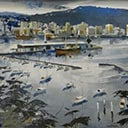Rangitikei River
60 x 75 cm
est. $25,000 - 35,000
Provenance:
Private Collection since c. 1969
Years ago I went far up the Rangitikei beyond Taihape to visit my friend David Russell, whose farm at that time was as far as you could drive up the river into the bush. The river is so deep between high paapa cliffs that down at the bottom where the river flows there is only a sort of twilight, even on a sunny day. Once I crossed the gorge at a wider place in the bush in a tray slung on a logger's wire rope, and we sat in mid-air watching a large trout feed in the river below where a patch of sun broke through the over-hanging bush. From that time on I have painted the river up and down its length, and always there has been delight in painting those lovely cliffs that are that most paintable of all colours - white.
Text: Peter McIntyre's New Zealand, A H & A W Reed 1964
The Rangitikei River, it's headwaters located to the southeast of Lake Taupo in the Kaimanawa Ranges stretches 185 kilometres, making it one of the New Zealand's longest rivers.
It flows from the Central Plateau south past Taihape, Mangaweka, Hunterville, Marton, Bulls and to the South Taranaki Bight at Tangimoana, 40 kilometres southeast of Wanganui. The river gives its name to the surrounding Rangitikei District. In 1897 the river flooded and all six bridges over it were damaged or destroyed. The port at the mouth of the river was also washed away and never rebuilt.
The river is a popular leisure and recreation area for jetboating, white water rafting, kayaking, fishing and includes public camping grounds along its banks. Its sheer vertical paapa (clay) cliffs, unique to this part of New Zealand, and deep canyons provide the perfect setting for adventure activities.
The lush green bush is the crowning glory of my country and in its depths the tui and bellbird sing the purest song of them all.
The river in the painting flows out of the bush, cutting deep into the white paapa clay to make cliffs that catch the sun and the moon all along its course.
Text: Peter McIntyre's Pacific, A H & A W Reed 1966
Peter McIntyre was born in Dunedin. His father, a lithographic artist, founded Dunedin's Caxton Printing Company. Young McIntyre attended Otago Boys' High School and the University of Otago. He studied painting under Dunedin artist Alfred O'Keeffe. McIntrye left New Zealand to study at London's Slade School of Art from 1931 until 1934. He worked in Britain as a free-lance artist until enlisting in 1939 with the 34th Anti-Tank Battery, a New Zealand unit formed in London. In 1941 whilst serving in Egypt, he was appointed as New Zealand's official war artist by General Freyberg. From 1941 to 1945 McIntyre recorded action in Crete, North Africa and Italy. His work was exhibited in New Zealand and Europe and reproduced in magazines such as the Illustrated London News and New Zealand Listener. His work from this period belongs to the collection of war art at the National Archives in Wellington.
Returning to New Zealand in 1946 McIntyre began a long and illustrious post war career. He lived and exhibited in Wellington, frequently undertaking painting trips abroad. In 1962 A H & A W Reed published The Painted Years, the first of eight books he would illustrate and write between then and 1981. Travels to Antarctica, Hong Kong, the Pacific Islands and the American West provided material for these popular publications. McIntyre owned a holiday cottage in Kakahi which became both his studio and retreat. The King Country inspired some of the artist's finest work and he painted the landscape, inhabitants, native bush, rivers and farming scenes of the central North Island.
In 1970 McIntyre was awarded an OBE. A retrospective exhibition of McIntyre's war paintings was held at the City Gallery in Wellington in 1995. Opening on 22 July, the show had been visited by more than 22,000 people when the artist died in Wellington on 11 September. Today he is recognised as one of New Zealand's most important landscape artists.





